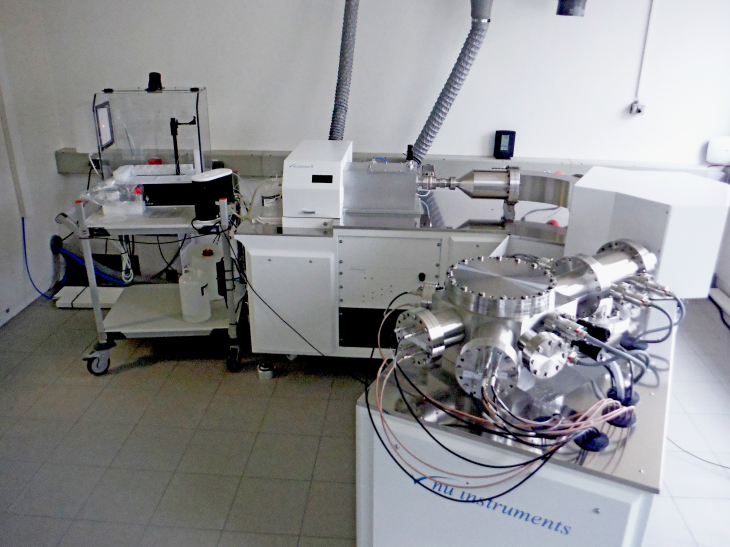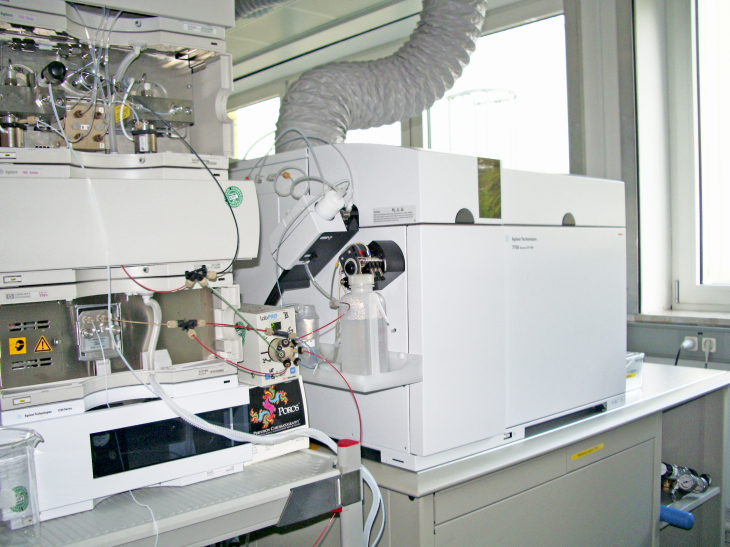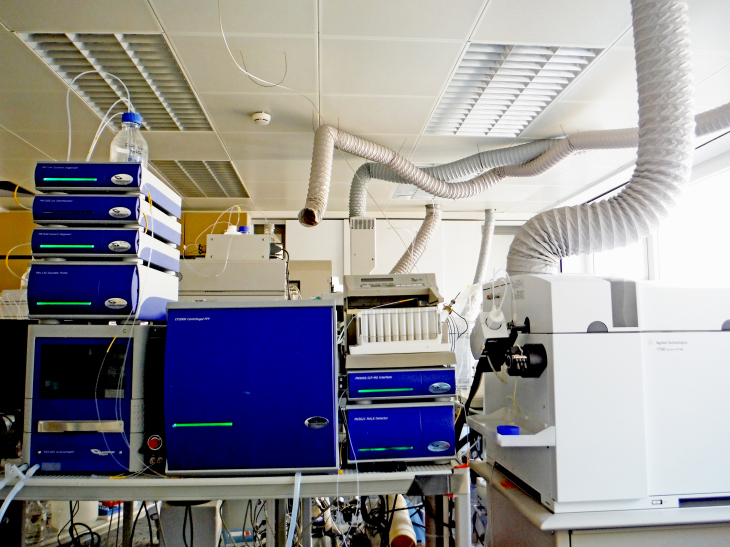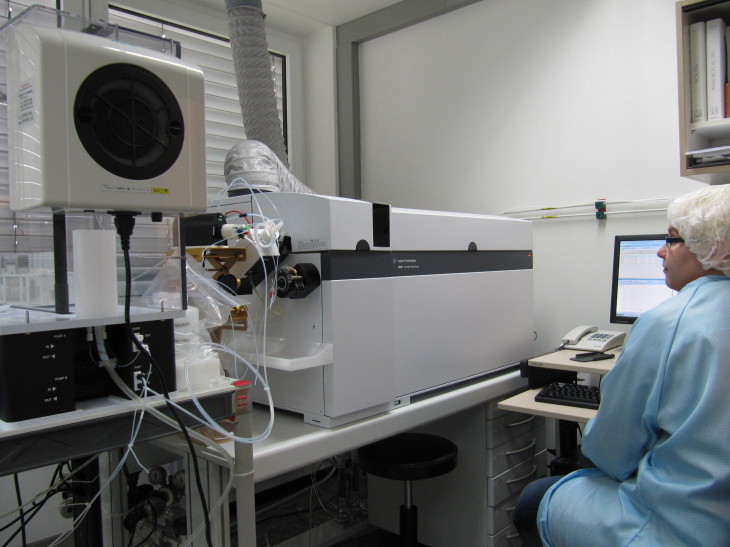Trace analysis of priority elements and emerging contaminants
In our laboratory an array of trace element and elementspecies analytical techniques is used for quantitative target analysis. Data on the contaminant concentration in environmental samples obtained from passive and active sampler reflecting the contamination level in different marine compartments. Additionally the tracing of sources of contaminants can be evaluated using isotopic systems.
The spectrum ranges from simultaneous multi element analysis, development of new methods for emerging inorganic compounds like nanoparticles as well as traditional and non-traditional isotopic ratios.
- Multielement Analysis
ICP and TXRF - Isotope Ratio Analysis
MC ICP - MS - Separation techniques
- Clean Laboratories
Inductively coupled plasma Techniques (ICP)

ICP-MS/MS system (Photo: Heike Helmholz/Hereon)
An Inductively Coupled Plasma (ICP) is a powerful ion source. Due to its high temperature of about 7000 K almost all molecules are atomised, excited and ionised. We use ICP-techniques in environmental research as well as for biological applications. The concentration of 40 to 50 elements can be determined.
The new Agilent 8800 ICP Triple Quad (ICP-QQQ) has a unique configuration with an additional quadrupole placed before the reaction cell. The Agilent 8800 provides consistent reaction processes in complex and variable samples, and offers a selective interference removal. The Agilent 8800 provides very high sensitivity and low random background, so detection limits are significantly improved. It is operated in under clean room conditions for multi element detection in water, sediment and biological samples.
Total Reflection X-Ray Fluorescence Spectrometry (TXRF)

TXRF System and Clean Bench (Photo: Heike Helmholz/Hereon)
TXRF is a robust and approved technique for chemical microanalysis and trace element analysis. Hereon (formerly GKSS) started R&D work on TXRF in the 1970s, which has resulted in several patents and license agreements with instrument manufacturers. Progress in TXRF instrumentation has been achieved since then in close cooperation with Hereon, and meanwhile the third generation of such instruments is used worldwide by analytical laboratories in research and industry.
Currently, our laboratory operates one spectrometer of the type (TXRF 8030C manufactured by Atomika Instruments) supplemented by an automated sample plate preparation System.
Many research activities of GKSS have used TXRF as a major analytical method, particularly in environmental research on the water cycle, on river and marine sediments, or on air pollution, just to name a few.
Multi collector inductively coupled plasma mass spectrometry

Multi collector ICP-MS (Photo: Heike Helmholz)
Instrument: Nu Plasma II (Nu Instruments Ltd., Wrexham, UK)
In 2014, a MC ICP-MS instrument was installed in our laboratories. The Nu Plasma II (Nu Instruments Ltd. Wrexham, UK) is a double focussing magnetic sector field instrument equipped with 18 Faraday detectors (55 volt dynamic range) and 5 ion counting multipliers that allow for measuring isotopes at different mass-to-charge ratios (m/z) simultaneously resulting in highly precise isotope ratio data. Furthermore, the high-resolution capabilities of the Nu Plasma II enable the separation of interferences in either edge-resolution or high-resolution mode by adjusting the slit system of the instrument. The ICP as ion source at atmospheric pressure enables easy hyphenation with different sample introduction systems, such as laser ablation, field flow fractionation, etc.
Almost all elements of the PSE can be analyzed and thus the fields of application of MC ICP-MS range broadly from cosmo-, geochemistry and geochronology, to biological and medical sciences, to provenance studies, life sciences, archaeometry and anthropology to nanoparticle analysis.
Hyphenation

HPLC-ICP-MS Coupling (Foto: Heike Helmholz)
This approach combines several techniques to solve one complex analytical task. In general hyphenated systems consist of highly efficient separation techniques which are coupled to different mass-spectrometric detectors.
Our laboratory is equipped with the following separation systems: three Capillary electrophoresis systems, one Gas Chromatograph, and five High-Performance Liquid Chromatography systems.
For element-specific detection we are using ICP-quadrupole mass spectrometer (Agilent 7500 c, Agilent 7500 cs/ce and Agilent 7700 cx) as well as a Multicollector ICP - MS. All instruments allow different hyphenated set-ups to be realized within minutes.
.
Centrifugal Field Flow Fractionation (CFFF)

CFFF-ICP-MS Coupling (Photo: Heike Helmholz)
The centrifugal field-flow-fractionation is a density/size separation method for micro- and nanoparticles which provides information about the size and the structure of the particles. When hyphenated to ICP-MS it also provides additional information about the quantity and the elemental and isotopic composition.
Our laboratory runs a CF2000 (PostNova) system that can be hyphenated to our ICP instruments in order to detect specifically Ti-NP or Ag-NP, respectively.
Clean laboratories for inorganic analysis (class 1.000 and 2x class 10.000)
The accurate determination of trace elements in various sample matrices is strongly influenced by the quality of the lab environment. Our laboratory is equipped with three clean rooms specially designed for inorganic trace analysis. Sample preparation as well as the measurement of elements at the ultra trace Level is conducted in these clean environments.

Clean labs are equipped with:
- Class 100 clean bench
- Sub-boiling systems for ultra pure acids
- Acid-vapor cleaning apparatus for PFA and quartz container preparation
- Centrifuges
- microwave sample extraction systems

- ICP-QQQ-MS (Agilent 8800) with collision cell
- Class 100 clean bench for ICP auto-sampler
- Class 100 clean bench for sample preparation
- Water purification system
